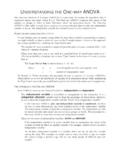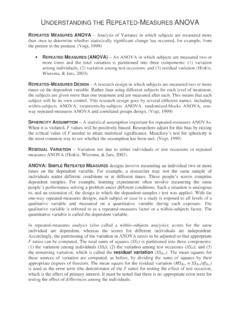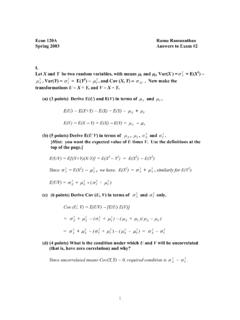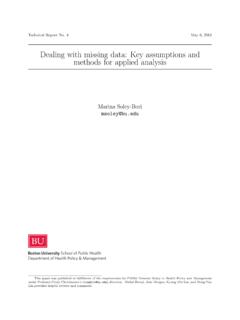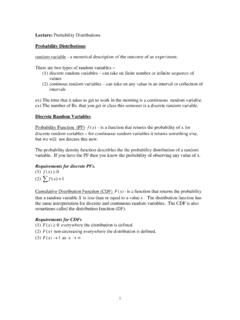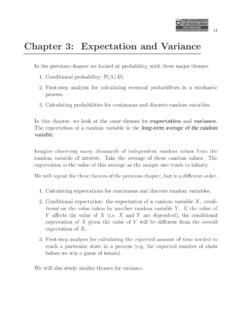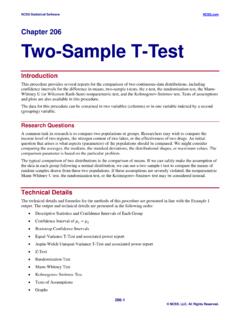Transcription of UNDERSTANDING ANALYSIS OF COVARIANCE (ANCOVA)
1 UNDERSTANDING ANALYSIS OF COVARIANCE (ANCOVA) In general, research is conducted for the purpose of explaining the effects of the independent variable on the dependent variable , and the purpose of research design is to provide a structure for the research. In the research design, the researcher identifies and controls independent variables that can help to explain the observed variation in the dependent variable , which in turn reduces error variance (unexplained variation). Since the research design is structured before the research begins, this method of control is called experimental control.
2 Research design the science (and art) of planning procedures for conducting studies so as to get the most valid findings. Called design for short. When designing a research study, one draws up a set of instructions for gathering evidence and for interpreting it. Experiments, quasi-experiments, double-blind procedures, and correlated groups design are examples of types of research design (Vogt, 1999). Control for to subtract statistically the effects of a variable (a control variable ) to see what a relationship would be without it (Vogt, 1999). Hold constant to subtract the effects of a variable from a complex relationship so as to study what the relationship would be if the variable were in fact a constant.
3 Holding a variable constant essentially means assigning it an average value (Vogt, 1999). In addition to controlling and explaining variation through research design, it is also possible to use statistical control to explain variation in the dependent variable . Statistical control, used when experimental control is difficult, if not impossible, can be achieved by measuring one or more variables in addition to the independent variables of primary interest and by controlling the variation attributed to these variables through statistical ANALYSIS rather than through research design.
4 The ANALYSIS procedure employed in this statistical control is ANALYSIS of COVARIANCE (ANCOVA). Statistical control using statistical techniques to isolate or subtract variance in the dependent variable attributable to variables that are not the subject of the study (Vogt, 1999). ANALYSIS of COVARIANCE (ANCOVA) an extension of ANOVA that provides a way of statistically controlling the (linear) effect of variables one does not want to examine in a study. These extraneous variables are called covariates, or control variables. (Covariates should be measured on an interval or ratio scale.)
5 ANCOVA allows you to remove covariates from the list of possible explanations of variance in the dependent variable . ANCOVA does this by using statistical techniques (such as regression to partial out the effects of covariates) rather than direct experimental methods to control extraneous variables. ANCOVA is used in experimental studies when researchers want to remove the effects of some antecedent variable . For example, pretest scores are used as covariates in pretest-posttest experimental designs. ANCOVA is also used in non-experimental research, such as surveys or nonrandom samples, or in quasi-experiments when subjects cannot be assigned randomly to control and experimental groups.
6 Although fairly common, the use of ANCOVA for non-experimental research is controversial (Vogt, 1999). ANCOVA Page 2 A one-way ANALYSIS of COVARIANCE (ANCOVA) evaluates whether population means on the dependent variable are the same across levels of a factor (independent variable ), adjusting for differences on the covariate, or more simply stated, whether the adjusted group means differ significantly from each other. With a one-way ANALYSIS of COVARIANCE , each individual or case must have scores on three variables: a factor or independent variable , a covariate, and a dependent variable .
7 The factor divides individuals into two or more groups or levels, while the covariate and the dependent variable differentiate individuals on quantitative dimensions. The one-way ANCOVA is used to analyze data from several types of studies; including studies with a pretest and random assignment of subjects to factor levels, studies with a pretest and assignment to factor levels based on the pretest, studies with a pretest, matching based on the pretest, and random assignment to factor levels, and studies with potential confounding (Green & Salkind, 2003).
8 The ANALYSIS of COVARIANCE (ANCOVA) is typically used to adjust or control for differences between the groups based on another, typically interval level, variable called the covariate. The ANCOVA is an extension of ANOVA that typically provides a way of statistically controlling for the effects of continuous or scale variables that you are concerned about but that are not the focal point or independent variable (s) in the study. For example, imagine that we found that boys and girls differ on math achievement. However, this could be due to the fact that boys take more math courses in high school.
9 ANCOVA allows us to adjust the math achievement scores based on the relationship between number of math courses taken and math achievement. We can then determine if boys and girls still have different math achievement scores after making the adjustment (Leech, Barrett, & Morgan, 2005). STATISTICAL CONTROL USING ANCOVA Controlling and explaining variation in the dependent variable can be accomplished with either experimental control, using research design, or statistical control, using ANALYSIS of COVARIANCE . ANALYSIS of COVARIANCE is used primarily as a procedure for the statistical control of an extraneous variable .
10 ANCOVA, which combines regression ANALYSIS and ANALYSIS of variance (ANOVA), controls for the effects of this extraneous variable , called a covariate, by partitioning out the variation attributed to this additional variable . In this way, the researcher is better able to investigate the effects of the primary independent variable . The ANCOVA F test evaluates whether the population means on the dependent variable , adjusted for differences on the covariate, differ across levels of a factor. If a factor has more than two levels and the F is significant, follow-up tests should be conducted to determine where there are differences on the adjusted means between groups.
